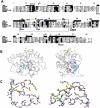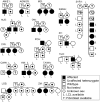The spectrum of WRN mutations in Werner syndrome patients
- PMID: 16673358
- PMCID: PMC1868417
- DOI: 10.1002/humu.20337
The spectrum of WRN mutations in Werner syndrome patients
Abstract
The International Registry of Werner syndrome (www.wernersyndrome.org) has been providing molecular diagnosis of the Werner syndrome (WS) for the past decade. The present communication summarizes, from among 99 WS subjects, the spectrum of 50 distinct mutations discovered by our group and by others since the WRN gene (also called RECQL2 or REQ3) was first cloned in 1996; 25 of these have not previously been published. All WRN mutations reported thus far have resulted in the elimination of the nuclear localization signal at the C-terminus of the protein, precluding functional interactions in the nucleus; thus, all could be classified as null mutations. We now report two new mutations in the N-terminus that result in instability of the WRN protein. Clinical data confirm that the most penetrant phenotype is bilateral ocular cataracts. Other cardinal signs were seen in more than 95% of the cases. The median age of death, previously reported to be in the range of 46-48 years, is 54 years. Lymphoblastoid cell lines (LCLs) have been cryopreserved from the majority of our index cases, including material from nuclear pedigrees. These, as well as inducible and complemented hTERT (catalytic subunit of human telomerase) immortalized skin fibroblast cell lines are available to qualified investigators.
Copyright 2006 Wiley-Liss, Inc.
Figures






References
-
- Ahn B, Harrigan JA, Indig FE, Wilson DM, 3rd, Bohr VA. Regulation of WRN helicase activity in human base excision repair. J Biol Chem. 2004;279:53465–53474. - PubMed
-
- Bennett RJ, Keck JL. Structure and function of RecQ DNA helicases. Crit Rev Biochem Mol Biol. 2004;39:79–97. - PubMed
-
- Chen L, Huang S, Lee L, Davalos A, Schiestl RH, Campisi J, Oshima J. WRN, the protein deficient in Werner syndrome, plays a critical structural role in optimizing DNA repair. Aging Cell. 2003a;2:191–199. - PubMed
Publication types
MeSH terms
Substances
Grants and funding
LinkOut - more resources
Full Text Sources
Other Literature Sources
Medical
Molecular Biology Databases
Miscellaneous

